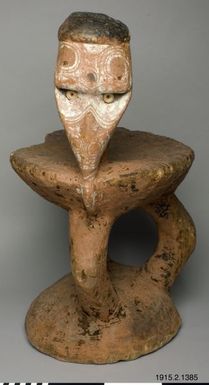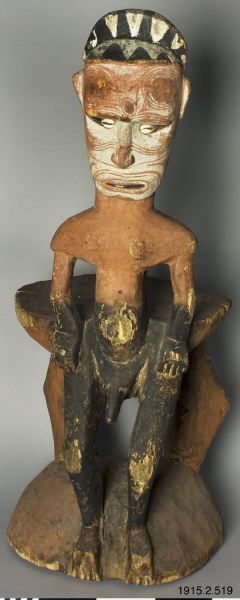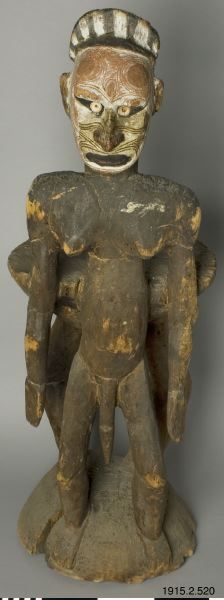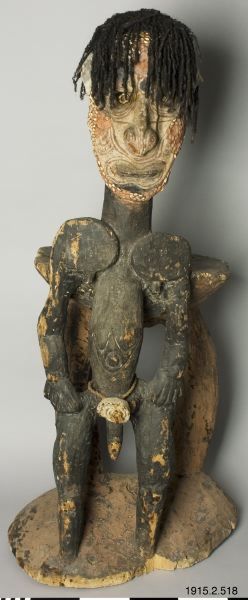stol, ceremonial chair
- Description:
- Chair of light brown wood with dark patina, cut from a piece of wood. At the bottom a round large pedestal from which four legs rise towards the seater. Two of the legs make up the body of a man’s figure that funnel as a backrest on the chair, the other two are bent. The figure is turned out of the chair. The figure has no feet. Arms hanging down from the body with hands dormant on the hips, each of which has five fingers. On the belly, the figure has a pattern reminiscent of a French lily, cut out in low relief and a twisted band of plant fiber stuck in a piece of fairytale palm pile decorated with cut circles. At the penis, the figure has clearly cut out testicles. At the shoulder part of the front side there are two hanging studs reminiscent of breasts. Long neck. A flat head modeled in red clay adorned along the edges and in the forehead with seeds of Jobs tears. Painted in white with red circles and curvy lines, painted black on the chin and three black circles in the forehead. Untruthful large pierced nose. Eyes made of seashells and marked eyebrows. Ears made of soldered sago palm pains attached to the head with the snare of plant fibres. At the top of the head is twisted black human hair stuck in the mud, under the hair sits a headband made of rattan. On the back the figure has clearly cut out shoulder blades. The chair is painted red. Chairs like this play an important ceremonial role in the Sepika area and mainly in Middle Sepik. They have never been used to sit on. They are usually placed at the middle pillar in the men’s ceremonial house and are the figurative representation of the most important village spirit. It also represents the spirit of the clan on whose land one built the men’s house. The chair has also had an important role in warfare, when profit or loss has been declared with the chair present or not present at the time of the war. Furthermore, the chair has an important role in political life. All cases concerning the village must be discussed with the presence of the chair. Whoever is to speak is standing his chair and holding a bundle of leaves in his hand. For every argument he puts forward, he puts a leaf on his chair to strength it. When finished, the leaves remain on his chair until the next speaker presents his ideas.
- Location:
- Papua New Guinea
- Format:
- image
- Collections:
- Museum of Ethnography
- Content partner:
- Museum of Ethnography
- Availability:
- Not specified
-
Copyright status: Share, modifyFind out more about what you are able to do with this itemMore informationMuseum of Ethnography has this to say about the rights status of this item:
http://creativecommons.org/publicdomain/zero/1.0/
What can I do with this item?Non-infringing useNZ copyright law does not prevent every use of a copyright work, and this item may be hosted by an international institute or organisation. You should consider what you can and cannot do with a copyright work.Share itThis item is suitable for copying and sharing with others, without further permission.Modify itThis item is suitable for modifying, remixing and building upon, without further permission.Check about commercial useYou'll need to confirm with the copyright holder using this item for commercial purposes.
Welcome and warm Pasifik greetings
The information on this site has been gathered from our content partners.
The names, terms, and labels that we present on the site may contain images or voices of deceased persons and may also reflect the bias, norms, and perspective of the period of time in which they were created. We accept that these may not be appropriate today.
If you have any concerns or questions about an item, please contact us.



